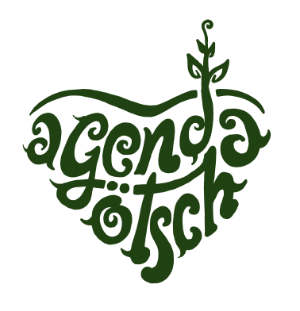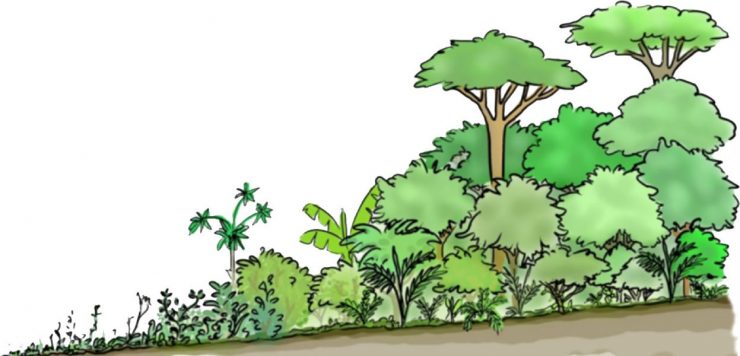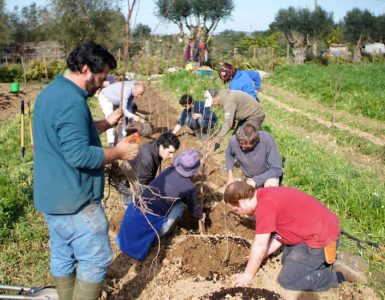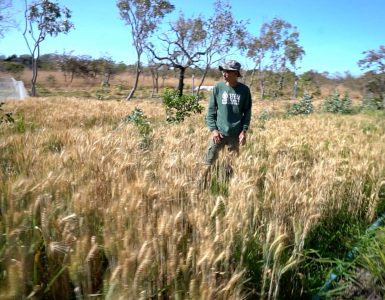An ecological concept according to the interpretation of Ernst Götsch
Natural succession is a concept generally associated with ecology and still receives little attention from agriculture. Although there is a consensus that agricultural practice is a form of applied ecology, the conceptual framework guiding agronomic research remains mostly governed by the logic of monoculture, far distant from the natural processes of an ecosystem.
After disturbances – such as opening a clearing – ecosystems restore their functionality and fertility through successional processes driven by a vast number of species. In plantations of annual and bi-annual species such as corn, soybeans and also in the production of vegetables, the situation is that of constant disturbances with physical or chemical interventions and constant reworking of the soil. Even when there is no soil disturbance, as in no-tillage systems, the course of vegetative succession is interrupted by the repetition of that annual crop, condemning the ecosystem to remain at an early stage of secondary succession.
This practice is based on the use of a resource accumulated in the form of natural capital that will invariably decrease with each repetition of planting – proven by the constant need to increase external inputs. The interpretation proposed by Ernst Götsch is that repeated interruptions of natural succession are the leading cause of ecosystem degradation.
In fact, before the emergence of agriculture, no human action had induced such environmental changes. In the first centuries of agricultural practice, fallow time (when the land is left uncultivated to “rest”) was 50 years, but this interval declined as population increased until the predominance of annual and biannual crops accelerated land degradation on a global scale. In general, natural environments did not have to deal with frequent vegetation losses before human intervention, whether associated with soil disturbances or not. (See “What is no-till?” box below)
The natural succession of species is the means used by nature to move in space and time “- E. Götsch

Example of natural succession in agriculture: in the upper photo, the eggplant dominates the scene. A short time before, in the same area, the corn stood out and was already harvested. Underneath the eggplant (photos below) we see the next plants of the succession: cassava, banana, and eucalyptus. The following consortia were planted with seeds or seedlings, among them citrus, mahogany, mango, avocado, açai, cacao, etc. Each species of each consortium will fit in time and space throughout the natural succession, in a steady increase of resources.

Natural succession, to Ernst Götsch, exposes the mechanisms of the collective behavior of life which dynamics induce transformations and adaptations to increase its ability to filter, digest and incorporate matter and energy of the sun into its systems, through a continuous process that follows cycles of growth and renewal.
As life forms evolve, they differentiate, adapt and incorporate information from the previous cycle. Given the inevitability of this trend, Ernst Götsch understands that natural succession is a key-knowledge for agriculture. Natural succession is the necessary information we humans should use to recreate and maintain our habitat in coherence with the natural tendency of the planet.
Agricultural innovations focused primarily on how to increase the efficiency of the entropic processes of de-assimilation and simplification (expiration), and did not study what took place in untouched areas (inspiration), where the activity of each generation of plants, animals and microorganisms delivers a more fertile environment for the next generation, “increasing resources across borders, in syntropy” – Ernst Götsch.
Therefore, the repetition of short-cycle crops or perennial monodominant plantations leads the ecosystem to degradative and entropic processes, despite its management practices, since it is prevented from fulfilling the inherent complexity of the successional process.
It favors not only soil erosion but also its compaction, mineralization of humified organic matter, loss of plant diversity, arthropods and mammals.
In a chain of effects, loss of biodiversity associated with physical impacts threatens the provision of ecosystem services and compromises vital functions such as pollination, biological control, and replenishment of groundwater.
The classification of Syntropic Farming in Systems of Colonization, Accumulation and Abundance maintain direct relations with the way Ernst Götsch distinguishes the moments of the successional escalate.
These systems differ mainly concerning the life forms present in each of them, the predominant processes in each case and the quantity and distribution of some macronutrients such as carbon, nitrogen and phosphorus.
But this is subject to an upcoming text!

What is NO-TILL? (Dayana Andrade)
Plowing and harrowing are typical stages of preparing an area, which consists of cutting and rolling the soil with the primary purpose of aerating and loosening the soil. However, the losses associated with this practice are many: erosion, loss of organic matter, compaction of deeper layers of soil, the death of micro and mesofauna of the soil, degradation of its aggregates, etc. No-tillage is a cultivation technique that seeks to avoid these impacts by suppressing the preparation stage of the area. In a no-till system, the sowing is done directly in furrows on the vegetable remains of the previous crop. The benefits would primarily be to reduce the effects of erosion, increase water holding capacity, reduce compaction, and reduce costs by a less fossil-fuel-dependent operation. On the other hand, the plowing and the harrowing, in addition to the objectives mentioned above, also play the role of mechanically combating spontaneous herbs. By suppressing this step, this supposed benefit is also lost. Because of this, no-tillage finds opponents who argue that this system would work only as a safeguard for the widespread use of herbicides and genetically modified seeds. The fact that there is a broad spectrum of no-tillage models ranging from the zero disturbance, through the minimal disturbance, to the unclear concept of "adequate disturbance". Anyway, this dispute does not find resonance within the perspective of Syntropic Farming because the preparation of the soil only happens once and, as the natural succession orients the planting, the system never goes back to the previous condition, dispensing new and frequent disturbances.






